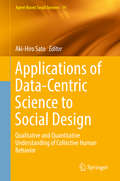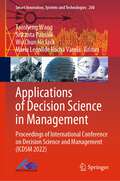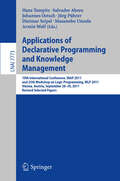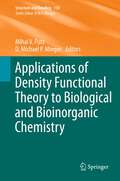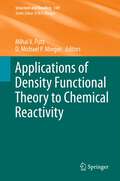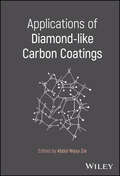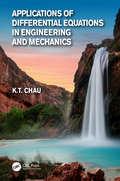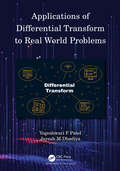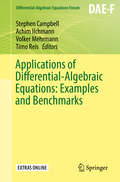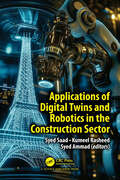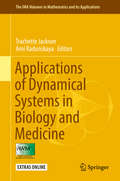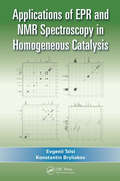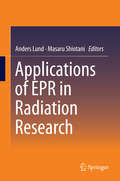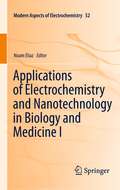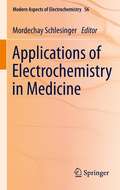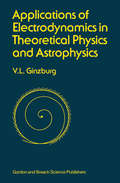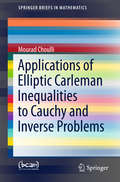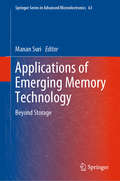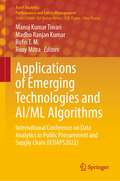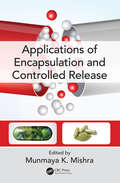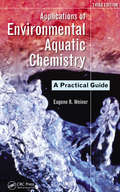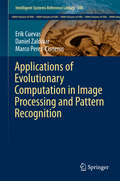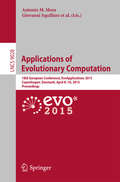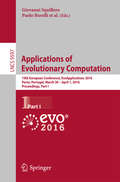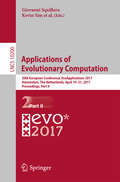- Table View
- List View
Applications of Data-Centric Science to Social Design: Qualitative and Quantitative Understanding of Collective Human Behavior (Agent-Based Social Systems #14)
by Aki-Hiro SatoThe intention behind this book is to illustrate the deep relation among human behavior, data-centric science, and social design. In fact, these three issues have been independently developing in different fields, although they are, of course, deeply interrelated to one another. Specifically, fundamental understanding of human behavior should be employed for investigating our human society and designing social systems. Insights and both quantitative and qualitative understandings of collective human behavior are quite useful when social systems are designed. Fundamental principles of human behavior, theoretical models of human behavior, and information cascades are addressed as aspects of human behavior. Data-driven investigation of human nature, social behavior, and societal systems are developed as aspects of data-centric science. As design aspects, how to design social systems from heterogeneous memberships is explained. There is also discussion of these three aspects—human behavior, data-centric science, and social design—independently and with regard to the relationships among them.
Applications of Decision Science in Management: Proceedings of International Conference on Decision Science and Management (ICDSM 2022) (Smart Innovation, Systems and Technologies #260)
by Srikanta Patnaik Taosheng Wang Maria Leonilde Rocha Varela Wu Chun Ho JackThis book covers research trends of data science and management involving cutting edge technologies and novel research directions from diverse fields of industries, business and government sectors. It involves usage of various advanced tools and techniques for understanding different data collected at the grassroot level to generate actionable insights for making crucial decisions. This book aims to serve as a reference book for researchers in the area of decision science for management. It covers alternative solutions with innovative ideas and issues from different fields of business management.
Applications of Declarative Programming and Knowledge Management: 19th International Conference, INAP 2011, and 25th Workshop on Logic Programming, WLP 2011, Vienna, Austria, September 28-30, 2011, Revised Selected Papers (Lecture Notes in Computer Science #7773)
by Hans Tompits Salvador Abreu Johannes Oetsch Jörg Pührer Dietmar Seipel Masanobu Umeda Armin WolfThis book constitutes revised selected papers of the 19th International Conference on Applications of Declarative Programming and Knowledge Management, INAP 2011, and the 25th Workshop on Logic Programming, WLP 2011, held in Vienna, Austria, in September 2011. The 19 papers presented in this volume were carefully reviewed and selected from 27 papers presented at the conference and initially a total of 35 submissions. The book also contains the papers of two invited talks. The papers are organized in topical sections on languages; answer-set programming and abductive reasoning; constraints and logic programming; answer-set programming and model expansion; application papers; and system descriptions.
Applications of Density Functional Theory to Biological and Bioinorganic Chemistry (Structure and Bonding #150)
by Mihai V. Putz D Michael MingosThe series Structure and Bonding publishes critical reviews on topics of research concerned with chemical structure and bonding. The scope of the series spans the entire Periodic Table and addresses structure and bonding issues associated with all of the elements. It also focuses attention on new and developing areas of modern structural and theoretical chemistry such as nanostructures, molecular electronics, designed molecular solids, surfaces, metal clusters and supramolecular structures. Physical and spectroscopic techniques used to determine, examine and model structures fall within the purview of Structure and Bonding to the extent that the focus is on the scientific results obtained and not on specialist information concerning the techniques themselves. Issues associated with the development of bonding models and generalizations that illuminate the reactivity pathways and rates of chemical processes are also relevant. The individual volumes in the series are thematic. The goal of each volume is to give the reader, whether at a university or in industry, a comprehensive overview of an area where new insights are emerging that are of interest to a larger scientific audience. Thus each review within the volume critically surveys one aspect of that topic and places it within the context of the volume as a whole. The most significant developments of the last 5 to 10 years should be presented using selected examples to illustrate the principles discussed. A description of the physical basis of the experimental techniques that have been used to provide the primary data may also be appropriate, if it has not been covered in detail elsewhere. The coverage need not be exhaustive in data, but should rather be conceptual, concentrating on the new principles being developed that will allow the reader, who is not a specialist in the area covered, to understand the data presented. Discussion of possible future research directions in the area is welcomed. Review articles for the individual volumes are invited by the volume editors. Readership: research scientists at universities or in industry, graduate students Special offer For all customers who have a standing order to the print version of Structure and Bonding, we offer free access to the electronic volumes of the Series published in the current year via SpringerLink.
Applications of Density Functional Theory to Chemical Reactivity (Structure and Bonding #149)
by D. Michael Mingos Mihai V. PutzThe series Structure and Bonding publishes critical reviews on topics of research concerned with chemical structure and bonding. The scope of the series spans the entire Periodic Table and addresses structure and bonding issues associated with all of the elements. It also focuses attention on new and developing areas of modern structural and theoretical chemistry such as nanostructures, molecular electronics, designed molecular solids, surfaces, metal clusters and supramolecular structures. Physical and spectroscopic techniques used to determine, examine and model structures fall within the purview of Structure and Bonding to the extent that the focus is on the scientific results obtained and not on specialist information concerning the techniques themselves. Issues associated with the development of bonding models and generalizations that illuminate the reactivity pathways and rates of chemical processes are also relevant. The individual volumes in the series are thematic. The goal of each volume is to give the reader, whether at a university or in industry, a comprehensive overview of an area where new insights are emerging that are of interest to a larger scientific audience. Thus each review within the volume critically surveys one aspect of that topic and places it within the context of the volume as a whole. The most significant developments of the last 5 to 10 years should be presented using selected examples to illustrate the principles discussed. A description of the physical basis of the experimental techniques that have been used to provide the primary data may also be appropriate, if it has not been covered in detail elsewhere. The coverage need not be exhaustive in data, but should rather be conceptual, concentrating on the new principles being developed that will allow the reader, who is not a specialist in the area covered, to understand the data presented. Discussion of possible future research directions in the area is welcomed. Review articles for the individual volumes are invited by the volume editors. Readership: research scientists at universities or in industry, graduate students Special offer For all customers who have a standing order to the print version of Structure and Bonding, we offer free access to the electronic volumes of the Series published in the current year via SpringerLink.
Applications of Diamond-like Carbon Coatings
by Abdul Wasy ZiaAn incisive guide to diamond-like carbon (DLC) coatings and their contemporary applications In Applications of Diamond-like Carbon Coatings, distinguished researcher Dr. Abdul Wasy Zia delivers an insightful and up-to-date discussion of the latest advancements in new and non-conventional applications of diamond-like carbon (DLC) coatings. The editor explains the transformation of typical topics into advanced applications of DLC, including tribology for future transportation solutions, green lubrication, invasive implants, MEMS, optical devices, and more. The book also details advanced and contemporary trends in DLC coatings, like material informatics involving artificial intelligence and machine learning, and new, net-zero applications, including energy storage batteries. Readers will also find: A thorough introduction to applications of DLC coatings in mechanics, transportation, medicine, and electrical and optical device manufacture Comprehensive explorations of emerging trends in DLC coatings, including green energy, data-centric approaches, textile and plastics, and carbon circularity from DLC coated productsPractical discussions of how small and medium industries can design and develop DLC coatings for broad engineering applications Complete treatments of the benefits and opportunities presented by DLC coating applications Perfect for postgraduate students and researchers with an interest in DLC coatings, Applications of Diamond-like Carbon Coatings will also benefit scholars and instructors in academia, technical managers, scientists, engineers, and corporate research and development professionals with backgrounds in chemistry, materials science, polymer chemistry, and physical chemistry.
Applications of Differential Equations in Engineering and Mechanics
by Kam Tim ChauThis second of two comprehensive reference texts on differential equations continues coverage of the essential material students they are likely to encounter in solving engineering and mechanics problems across the field - alongside a preliminary volume on theory. This book covers a very broad range of problems, including beams and columns, plates, shells, structural dynamics, catenary and cable suspension bridge, nonlinear buckling, transports and waves in fluids, geophysical fluid flows, nonlinear waves and solitons, Maxwell equations, Schrodinger equations, celestial mechanics and fracture mechanics and dynamics. The focus is on the mathematical technique for solving the differential equations involved. All readers who are concerned with and interested in engineering mechanics problems, climate change, and nanotechnology will find topics covered in this book providing valuable information and mathematics background for their multi-disciplinary research and education.
Applications of Differential Transform to Real World Problems
by Yogeshwari F Patel Jayesh M DhodiyaThis book is an invaluable resource for applied researchers to find the analytical solution of differential equations describing the dynamical system with less computational effort and time. It describes the basic concepts of the differential transform method and solution of various real-world problems described by simple to complicated differential equations. It provides a computational technique that is not only conceptually simple and easy to use but also readily adaptable for computer coding. Different chapters of the book deal with the basic differential equations involved in the physical phenomena as well as a complicated system of differential equations described by the mathematical model.The book offers comprehensive coverage of the most essential topics, including Basic concepts and fundamental properties of the proposed technique with proof The solution of linear, nonlinear, homogeneous, and nonhomogeneous ordinary differential equations (ODEs) and partial differential equations (PDEs) The initial and boundary value problems Real-world ODE and PDE problems are also discussed Applications of Differential Transform to Real World Problems is primarily aimed at undergraduates, graduates, and researchers studying differential equations. Scientists dealing with complicated differential equations or systems of differential equations will also find this book useful.
Applications of Differential-Algebraic Equations: Examples and Benchmarks (Differential-Algebraic Equations Forum)
by Achim Ilchmann Timo Reis Volker Mehrmann Stephen CampbellThis volume encompasses prototypical, innovative and emerging examples and benchmarks of Differential-Algebraic Equations (DAEs) and their applications, such as electrical networks, chemical reactors, multibody systems, and multiphysics models, to name but a few. Each article begins with an exposition of modelling, explaining whether the model is prototypical and for which applications it is used. This is followed by a mathematical analysis, and if appropriate, a discussion of the numerical aspects including simulation. Additionally, benchmark examples are included throughout the text.Mathematicians, engineers, and other scientists, working in both academia and industry either on differential-algebraic equations and systems or on problems where the tools and insight provided by differential-algebraic equations could be useful, would find this book resourceful.
Applications of Digital Twins and Robotics in the Construction Sector
by Syed Saad Syed Ammad Kumeel RasheedThis book provides insights to the lay person as well as the experts who are actively enabling these changes in the construction industry. The book explores digital twins and robots in the construction sector, and how they are revolutionizing this field. It comprises chapters that begin with the basics before going upstream. Digital Twins are important in the planning and design of projects where, real-time simulation, visualization and data-driven decision-making are done. Furthermore, robotics play a significant role in on-site execution, thus automating construction operations, and guaranteeing accuracy and safety. The book discusses the harmony of digital twinning and robotics, showing that these two are complementary with regard to enhancing efficiencies on-site, in monitoring progress and live control.Applications of Digital Twins and Robotics in the Construction Sector covers the current applications of these technologies and forecasts future applications, exposing readers to breakthrough innovations transforming this field. It aims inform all readers, expert or simply interested and inquisitive about digital twins and construction robots’ transformation.
Applications of Dynamical Systems in Biology and Medicine (The IMA Volumes in Mathematics and its Applications #158)
by Trachette Jackson Ami RadunskayaThis volume highlights problems from a range of biological and medical applications that can be interpreted as questions about system behavior or control. Topics include drug resistance in cancer and malaria, biological fluid dynamics, auto-regulation in the kidney, anti-coagulation therapy, evolutionary diversification and photo-transduction. Mathematical techniques used to describe and investigate these biological and medical problems include ordinary, partial and stochastic differentiation equations, hybrid discrete-continuous approaches, as well as 2 and 3D numerical simulation.
Applications of EPR and NMR Spectroscopy in Homogeneous Catalysis
by Evgenii Talsi Konstantin BryliakovThis book reviews advances in important and practically relevant homogeneous catalytic transformations, such as single-site olefin polymerizations and chemo- and stereo-selective oxidations. Close attention is paid to the experimental investigation of the active sites of catalytic oxidation systems and their mechanisms. Major subjects include the applications of NMR and EPR spectroscopic techniques and data obtained by other physical methods. The book addresses a broad readership and focus on widespread techniques available in labs with NMR and EPR spectrometers.
Applications of EPR in Radiation Research
by Anders Lund Masaru ShiotaniApplications of EPR in Radiation Research is a multi-author contributed volume presented in eight themes: I. Elementary radiation processes (in situ and low temperature radiolysis, quantum solids); II: Solid state radiation chemistry (crystalline, amorphous and heterogeneous systems); III: Biochemistry, biophysics and biology applications (radicals in biomaterials, spin trapping, free-radical-induced DNA damage); IV: Materials science (polymeric and electronic materials, materials for treatment of nuclear waste, irradiated food); V: Radiation metrology (EPR-dosimetry, retrospective and medical applications); VI: Geological dating; VII: Advanced techniques (PELDOR, ESE and ENDOR spectroscopy, matrix isolation); VIII: Theoretical tools (density-functional calculations, spectrum simulations).
Applications of Electrochemistry and Nanotechnology in Biology and Medicine I (Modern Aspects of Electrochemistry #52)
by Noam EliazThe study of electrochemical nanotechnology has emerged as researchers apply electrochemistry to nanoscience and nanotechnology. These two related volumes in the Modern Aspects of Electrochemistry Series review recent developments and breakthroughs in the specific application of electrochemistry and nanotechnology to biology and medicine. Internationally renowned experts contribute chapters that address both fundamental and practical aspects of several key emerging technologies in biomedicine, such as the processing of new biomaterials, biofunctionalization of surfaces, characterization of biomaterials, discovery of novel phenomena and biological processes occurring at the molecular level.
Applications of Electrochemistry in Medicine (Modern Aspects of Electrochemistry #56)
by Mordechay SchlesingerMedical Applications of Electrochemistry, a volume of the series Modern Aspects of Electrochemistry, illustrates the interdisciplinary nature of modern science by indicating the many current issues in medicine that are susceptible to solution by electrochemical methods. This book also suggests how personalized medicine can develop.
Applications of Electrodynamics in Theoretical Physics and Astrophysics
by David GinsburgTreats certain problems and methods of theoretical physics and astrophysics which are associated with microscopic and macroscopic electrodynamics and material concerning the theory of transition radiation and transition scattering.
Applications of Elliptic Carleman Inequalities to Cauchy and Inverse Problems (SpringerBriefs in Mathematics)
by Mourad ChoulliThis book presents a unifiedapproach to studying the stability of both elliptic Cauchy problems and selectedinverse problems. Based on elementary Carleman inequalities, it establishesthree-ball inequalities, which are the key to deriving logarithmic stabilityestimates for elliptic Cauchy problems and are also useful in proving stabilityestimates for certain elliptic inverse problems. The book presents three inverseproblems, the first of which consists in determining the surface impedance ofan obstacle from the far field pattern. The second problem investigates the detectionof corrosion by electric measurement, while the third concerns thedetermination of an attenuation coefficient from internal data, which ismotivated by a problem encountered in biomedical imaging.
Applications of Emerging Memory Technology: Beyond Storage (Springer Series in Advanced Microelectronics #63)
by Manan SuriThe book intends to bring under one roof research work of leading groups from across the globe working on advanced applications of emerging memory technology nanodevices. The applications dealt in the text will be beyond conventional storage application of semiconductor memory devices. The text will deal with material and device physical principles that give rise to interesting characteristics and phenomena in the emerging memory device that can be exploited for a wide variety of applications. Applications covered will include system-centric cases such as – caches, NVSRAM, NVTCAM, Hybrid CMOS-RRAM circuits for: Machine Learning, In-Memory Computing, Hardware Security - RNG/PUF, Biosensing and other misc beyond storage applications. The book is envisioned for multi-purpose use as a textbook in advanced UG/PG courses and a research text for scientists working in the domain.
Applications of Emerging Technologies and AI/ML Algorithms: International Conference on Data Analytics in Public Procurement and Supply Chain (ICDAPS2022) (Asset Analytics)
by Manoj Kumar Tiwari Madhu Ranjan Kumar Rofin T. M. Rony MitraThis book provides practical insights into applications of the state-of-the-art of Machine Learning and Artificial Intelligence (AI) for solving intriguing and complex problems in procurement and supply chain management. The application domain includes perishable food supply chain, steel price prediction, electric vehicle charging infrastructure design, contract price negotiation, reverse logistics network design, and demand forecasting. Further, the book highlights the advanced topics in the procurement field, like AI in green procurement and e-procurement in the pharma sector. Furthermore, the book covers applications of well-established methodologies such as heuristics, optimization, game theory, and MCDM based on the nature of the problem. The inclusion of the vaccine supply chain digital twin and blockchain-based procurement signals the significance of the book. This book is a comprehensive guide for industry professionals to understand the power of data analytics, enabling them to improve efficiency and effectiveness in the procurement and supply chain sectors.
Applications of Encapsulation and Controlled Release (Encapsulation and Controlled Release)
by Munmaya K. MishraThe field of encapsulation, especially microencapsulation, is a rapidly growing area of research and product development. Applications of Encapsulation and Controlled Release offers a broad perspective on a variety of applications and processes, including, up-to-date research, figures, tables, illustrations, and references. Written at a level comprehensible to non-experts, it is a rich source of technical information and current practices in research and industry.
Applications of Environmental Aquatic Chemistry: A Practical Guide, Third Edition
by Eugene R. WeinerProfessionals and students who come from disciplines other than chemistry need a concise yet reliable guide that explains key concepts in environmental chemistry, from the fundamental science to the necessary calculations for applying them. Updated and reorganized, Applications of Environmental Aquatic Chemistry: A Practical Guide, Third Edition pr
Applications of Evolutionary Computation in Image Processing and Pattern Recognition (Intelligent Systems Reference Library #100)
by Erik Cuevas Daniel Zaldívar Marco Perez-CisnerosThis book presents the use of efficientEvolutionary Computation (EC) algorithms for solving diverse real-world imageprocessing and pattern recognition problems. It provides an overview of thedifferent aspects of evolutionary methods in order to enable the reader inreaching a global understanding of the field and, in conducting studies onspecific evolutionary techniques that are related to applications in imageprocessing and pattern recognition. It explains the basic ideas of the proposedapplications in a way that can also be understood by readers outside of thefield. Image processing and pattern recognition practitioners who are notevolutionary computation researchers will appreciate the discussed techniquesbeyond simple theoretical tools since they have been adapted to solvesignificant problems that commonly arise on such areas. On the other hand,members of the evolutionary computation community can learn the way in whichimage processing and pattern recognition problems can be translated into anoptimization task. The book has been structured so that each chapter can beread independently from the others. It can serve as reference book for studentsand researchers with basic knowledge in image processing and EC methods.
Applications of Evolutionary Computation: 18th European Conference, EvoApplications 2015, Copenhagen, Denmark, April 8-10, 2015, Proceedings (Lecture Notes in Computer Science #9028)
by Giovanni Squillero Antonio M. MoraThis book constitutes the refereed conference proceedings of the 18th International Conference on the Applications of Evolutionary Computation, EvoApplications 2015, held in Copenhagen, Spain, in April 2015, colocated with the Evo 2015 events EuroGP, EvoCOP, and EvoMUSART. The 72 revised full papers presented were carefully reviewed and selected from 125 submissions. EvoApplications 2015 consisted of the following 13 tracks: EvoBIO (evolutionary computation, machine learning and data mining in computational biology), EvoCOMNET (nature-inspired techniques for telecommunication networks and other parallel and distributed systems), EvoCOMPLEX (evolutionary algorithms and complex systems), EvoENERGY (evolutionary computation in energy applications), EvoFIN (evolutionary and natural computation in finance and economics), EvoGAMES (bio-inspired algorithms in games), EvoIASP (evolutionary computation in image analysis, signal processing, and pattern recognition), EvoINDUSTRY (nature-inspired techniques in industrial settings), EvoNUM (bio-inspired algorithms for continuous parameter optimization), EvoPAR (parallel implementation of evolutionary algorithms), EvoRISK (computational intelligence for risk management, security and defence applications), EvoROBOT (evolutionary computation in robotics), and EvoSTOC (evolutionary algorithms in stochastic and dynamic environments).
Applications of Evolutionary Computation: 19th European Conference, EvoApplications 2016, Porto, Portugal, March 30 -- April 1, 2016, Proceedings, Part I (Lecture Notes in Computer Science #9597)
by Paolo Burelli Giovanni SquilleroThetwo volumes LNCS 9597 and 9598 constitute the refereed conference proceedingsof the 19th European Conference on the Applications of Evolutionary Computation,EvoApplications 2016, held in Porto, Portugal, in March/April 2016, co-locatedwith the Evo* 2016 events EuroGP, EvoCOP, and EvoMUSART. The57 revised full papers presented together with 17 poster papers were carefullyreviewed and selected from 115 submissions. EvoApplications 2016 consisted ofthe following 13 tracks: EvoBAFIN (natural computing methods in businessanalytics and finance), EvoBIO (evolutionary computation, machine learning anddata mining in computational biology), EvoCOMNET (nature-inspired techniquesfor telecommunication networks and other parallel and distributed systems),EvoCOMPLEX (evolutionary algorithms and complex systems), EvoENERGY(evolutionary computation in energy applications), EvoGAMES (bio-inspiredalgorithms in games), EvoIASP (evolutionary computation in image analysis,signal processing, and pattern recognition), EvoINDUSTRY (nature-inspiredtechniques in industrial settings), EvoNUM (bio-inspired algorithms forcontinuous parameter optimization), EvoPAR (parallel implementation ofevolutionary algorithms), EvoRISK (computational intelligence for riskmanagement, security and defence applications), EvoROBOT (evolutionaryrobotics), and EvoSTOC (evolutionary algorithms in stochastic and dynamicenvironments).
Applications of Evolutionary Computation: 19th European Conference, Evoapplications 2016, Porto, Portugal, March 30 -- April 1, 2016, Proceedings, Part I (Lecture Notes in Computer Science #9597)
by Kevin Sim Giovanni SquilleroThis book constitutes the refereed conference proceedings of the 18th International Conference on the Applications of Evolutionary Computation, EvoApplications 2015, held in Copenhagen, Spain, in April 2015, colocated with the Evo 2015 events EuroGP, EvoCOP, and EvoMUSART. The 72 revised full papers presented were carefully reviewed and selected from 125 submissions. EvoApplications 2015 consisted of the following 13 tracks: EvoBIO (evolutionary computation, machine learning and data mining in computational biology), EvoCOMNET (nature-inspired techniques for telecommunication networks and other parallel and distributed systems), EvoCOMPLEX (evolutionary algorithms and complex systems), EvoENERGY (evolutionary computation in energy applications), EvoFIN (evolutionary and natural computation in finance and economics), EvoGAMES (bio-inspired algorithms in games), EvoIASP (evolutionary computation in image analysis, signal processing, and pattern recognition), EvoINDUSTRY (nature-inspired techniques in industrial settings), EvoNUM (bio-inspired algorithms for continuous parameter optimization), EvoPAR (parallel implementation of evolutionary algorithms), EvoRISK (computational intelligence for risk management, security and defence applications), EvoROBOT (evolutionary computation in robotics), and EvoSTOC (evolutionary algorithms in stochastic and dynamic environments).
